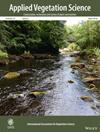Woody Vegetation Dynamics in a Protected African Savanna: Insights From Vegetation Resurvey of the Gonarezhou National Park, Zimbabwe
Abstract
Aims
This study assessed changes in woody vegetation cover, richness, diversity, and species composition in Gonarezhou National Park (GNP) between 2010 and 2023, focusing on the impacts of fire and elephants. Analyses were conducted for the entire park and its main vegetation types and ecoregions.
Location
GNP is located in southern Zimbabwe, bordering Mozambique, covering approximately 5000 km2.
Methods
In 2010, 313 sampling areas were surveyed, and a resurvey was conducted in 2022/2023 using a plotless method. For each area, woody species cover was recorded in four height classes. Indices for total woody cover, species richness, diversity (Shannon), and evenness (Pielou) were calculated for both surveys across the park, ecoregions, and vegetation types. Differences between surveys were analyzed with paired t-tests. Species composition changes were analyzed using NMDS and PERMANOVA, while the effects of fire frequency, slope, and distance from rivers on species composition were tested with a mixed linear model. The change in dominant species occurrence was also examined.
Results
Species richness significantly declined, with no changes in woody vegetation cover, diversity, or evenness, except in the alluvial ecoregion, where diversity decreased. Changes across height layers revealed increased richness and diversity in the < 1 m layer and declines in the 1–3 m and 3–5 m layers. Species composition changes were significant across ecoregions and influenced by fire frequency. A decrease in dominant tree species was observed, varying by species' resilience to current pressures.
Conclusions
GNP is undergoing simplification in woody vegetation, likely due to the combined effects of elephants and fire. This is leading to shrubbier vegetation and changes in species composition, particularly in trees. To prevent further degradation, actions must be implemented, such as the use of individual protection systems from debarking, the development of a fire management system, and the creation of ecological corridors in the Greater Limpopo Transfrontier Conservation Area to facilitate the movement of elephants.


 求助内容:
求助内容: 应助结果提醒方式:
应助结果提醒方式:


